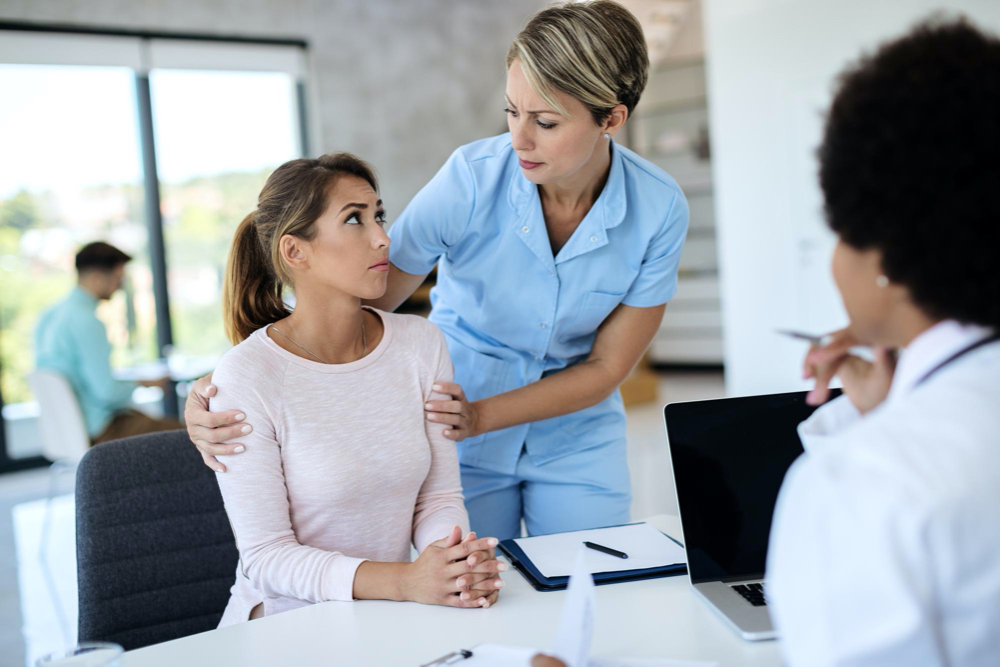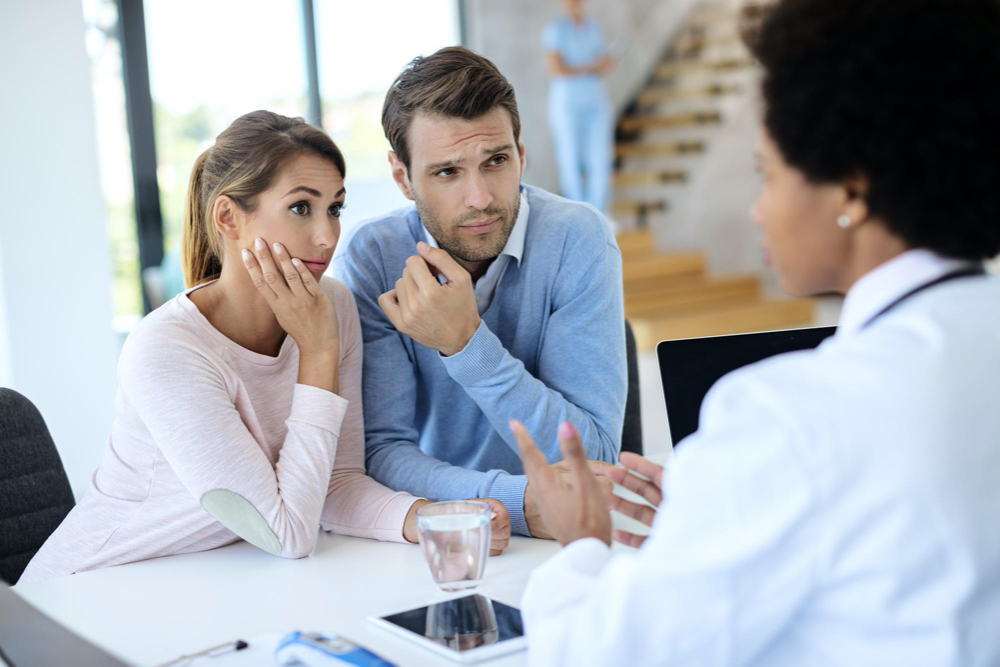- Fast results
- 4,000+ locations
- 4.8 star rating
Need Help? (888) GET LABS



Endometriosis affects 6-10% of women in the US. However, many women tend to brush it off and endure the symptoms until it’s too late.
Women with endometriosis suffer from minimal to severe pain, especially during menstruation. But it also triggers gastrointestinal problems, depression, anxiety, and infertility if not treated immediately. With these impacts, women should take endometriosis seriously.
So, if you are experiencing unusual discomfort in your reproductive area, it is best to check with your gynecologist for proper diagnosis and treatment.
Endometriosis develops when tissues found inside the uterus grow out of place. In the menstrual cycle, tissues in the uterine lining or endometrium are shed during menstruation and will regrow as the uterus rebuilds itself.
However, with women diagnosed with endometriosis, the tissue grows outside the uterus, such as in the ovaries and fallopian tubes.
The exact cause of endometriosis remains unknown. However, several factors have been associated with the condition, including the following:
Retrograde menstruation occurs when menstrual blood containing endometrial cells moves toward the pelvic cavity instead of exiting the vagina. As a result, the cells stick to your ovaries and fallopian tubes, leading to abnormal tissue growth.
It is considered the primary mechanism of how endometriosis develops in many women.
As to why retrograde menstruation happens, the cause is still unknown. Nonetheless, the upward movement of the blood is linked to uterine contractions that go out of sync.
Likewise, symptoms for retrograde menstruation are also vague. Hence, it’s trickier to detect the condition until it turns to endometriosis.
If anyone in your family has been diagnosed with endometriosis, you are most likely at risk for the condition. However, this could also depend on environmental factors.
According to research, the genes involved in endometriosis are multifactorial in nature. This means that the condition will not manifest unless external factors trigger the disorder.
High estrogen appears to also promote endometriosis. A type of estrogen called estradiol regulates tissue growth in the uterus. However, high levels of the said hormone could lead to inflammation triggering mild to severe pain.
Furthermore, women with endometriosis consistently have higher estrogen levels than those who don’t have the condition. With this in mind, it’s beneficial to have your estradiol checked via blood test, especially if you experience symptoms of endometriosis.
Some women experience severe endometriosis symptoms, while others only go through mild counterparts. Nonetheless, pelvic pain remains the most common indicator of endometriosis. But, it may also include the following:
When you’re diagnosed with endometriosis, one of the things your gynecologist will assess first is the stage. The condition has four stages determined by quantity, location, depth of growth, size, etc.
Stage 1: Minimal – Fewer, small, and superficial endometrial implants.
Stage 2 Mild – Deeper and more endometrial implants develop. Scar tissue can form, but no active inflammation.
Stage 3: Moderate – Many deep implants and small cysts on one or two ovaries.
Stage 4: Severe – Many deep implants and large cysts on one or both ovaries.
Despite its relatively tolerable symptoms, endometriosis should be taken seriously. It can affect your daily activities due to chronic pain in the lower areas of your body, affecting your mobility. Plus, untreated endometriosis can cause infertility. Therefore, if you’re planning to have children, it’s best to address the condition as early as possible.
Moreover, detecting and treating endometriosis at the earliest stage improves your quality of life.
Unfortunately, endometriosis has no cure, but treatments are available to alleviate suffering and prevent other related conditions from developing.

Here are some of the complications women face with endometriosis.
Endometriosis is one of the leading causes of infertility. According to research, 5 million women in their 30s and 40s are affected by this condition in the US – with 2 out of 5 women experiencing fertility problems.
The abnormal tissue growth involved in endometriosis leads to anatomical changes in the female reproductive organs, making it challenging to carry a full term.
Some women can also develop adhesions or sticky fluid forming in the endometrial tissue. This can make the uterus, fallopian tubes, and bowel stick together.
In addition, ovarian cysts or the fluid-full cysts in your ovaries can become larger and more painful. You may need to undergo surgery if this is the case.
However, it is likely that the cysts won’t disappear for good. It may also come back if the endometriosis grows back again.
The proximity of the uterus to the colorectal region and urinary bladder makes these organs prone to complications when you have endometriosis. In addition, as the tissue grows abnormally, it can affect organ form and function, leading to problems with the said internal organs.
If your bladder and bowel movements are affected by endometriosis, chances are you have to undergo major surgery. In addition, these problems can be challenging to treat. Therefore, you may be advised to get a specialist for proper treatment.
Endometriosis and Fibroids both develop in the uterus. However, endometriosis occurs when tissues in the uterine lining abnormally develop outside the uterus.
Meanwhile, fibroids are non-cancerous muscle tumors that grow inside or around the uterus with rare symptoms. It is also called uterine myoma.
If you have symptoms of endometriosis, doctors will perform these tests for diagnosis:
If you’re not a fan of invasive procedures, your doctor could still diagnose endometriosis through a blood test.
However, you still need to be open to the possibility of undergoing the above mentioned procedures. In addition, your gynecologist may still advise laparoscopy or biopsy as serum tests may not be enough depending on the case.
Endometriosis can be diagnosed by taking a blood test called the CA-125 blood test. This type of test can detect 9 out of 10 cases of the disease.
CA-125 blood test screens for glycoprotein markers suggesting mass formation in the pelvic area. It is also used to help diagnose endometrial and ovarian cancer as well as in monitoring cancer therapy. High levels of CA-125 could indicate abnormalities in these regions.
Unfortunately, endometriosis does not dissolve or disappear on its own. Drastic consequences can appear if the condition is left untreated. Not to mention the painful discomfort it brings daily, especially during menstruation.
On the other hand, complex complications with endometriosis also progress over time. So, for example, the chances of getting pregnant go even lower if you don’t undergo treatment.
Also, women with endometriosis have a higher risk of developing ovarian cancer. Another worst-case scenario is to develop endometrial cancer if left undiagnosed and untreated.
Endometriosis treatment commonly involves medication and surgery.
Your doctor usually recommends taking an over-the-counter pain reliever. Also, you may need supplemental hormones due to the irregular rise and fall of your hormones during your menstrual cycle.
Moreover, if you are trying to get pregnant, you may also undergo conservative surgery. This will depend on your doctor’s assessment and the existence of other reproductive conditions.
Doctors perform a hysterectomy, or the removal of the uterus, to treat the symptoms of endometriosis. But this procedure still does not guarantee a 100% cure for the signs. Nonetheless, the procedure is often performed when the condition becomes too severe for other treatment alternatives.
There is no research that proves endometriosis can be cured organically. However, there are some treatments developed by specialists to lessen the severity of the symptoms of the disorder.
Aside from scientific treatments such as medication and surgery, fortunately, you could alleviate the symptoms of endometriosis using other alternatives.

Endometriosis symptoms could occur anytime during the menstrual cycle. But it’s notably common during menstruation wherein the uterus tissues are shed out.
Chronic pain is the typical complaint among women diagnosed with the condition. Fortunately, you can rely on medications and home remedies to address the symptoms.
Ibuprofen (Motrin) and Naproxen (Naprosyn) are some of the best pain relievers for endometriosis. These offer a fast relief for your cramps caused by the disorder.
Due to its potent anti-inflammatory properties, taking turmeric capsules or tea helps to alleviate endometriosis symptoms.
It is a staple for treating menstrual cramps due to its healing properties. Massaging castor oil into your abdomen can help break up congestion and increase blood circulation in your reproductive area. As a result, it reduces inflammation.
Warm baths or hot water bottles treat cramps efficiently. In addition, heat improves circulation in the pelvic area by encouraging blood vessel dilation allowing smoother blood flow.
What you eat could help you manage pelvic pain. However, some reduce inflammation, and some could aggravate the pain. Hence, it only makes sense to avoid inflammatory foods and go for alternatives that provide an opposite effect.
Massaging your pelvic area, including your abdomen, sides, and lower back, can relax the muscles and reduce inflammation. However, pelvic massage is advised before your period.
It is considered one of the best home remedies in dealing with nausea. Women with endometriosis experience nausea, so ginger tea is preferred because it is safer and more effective.
To sum it up, endometriosis is a health disorder that should be taken seriously. This means seeing your gynecologist at the onset of symptoms and going through the diagnostic procedure and recommended treatment plan.
While endometriosis is not fatal, its complications can cause physical and mental constraints. If you plan on having a baby, treating endometriosis and other gynecological conditions is crucial.
That being said, you could also benefit from a regular women’s heath tests as part of your annual wellness checkup to ensure your reproductive health by screening for any imbalance or infection. Take better control of your health by taking action against endometriosis.

© Copyright 2025 Personalabs. All Rights Reserved.